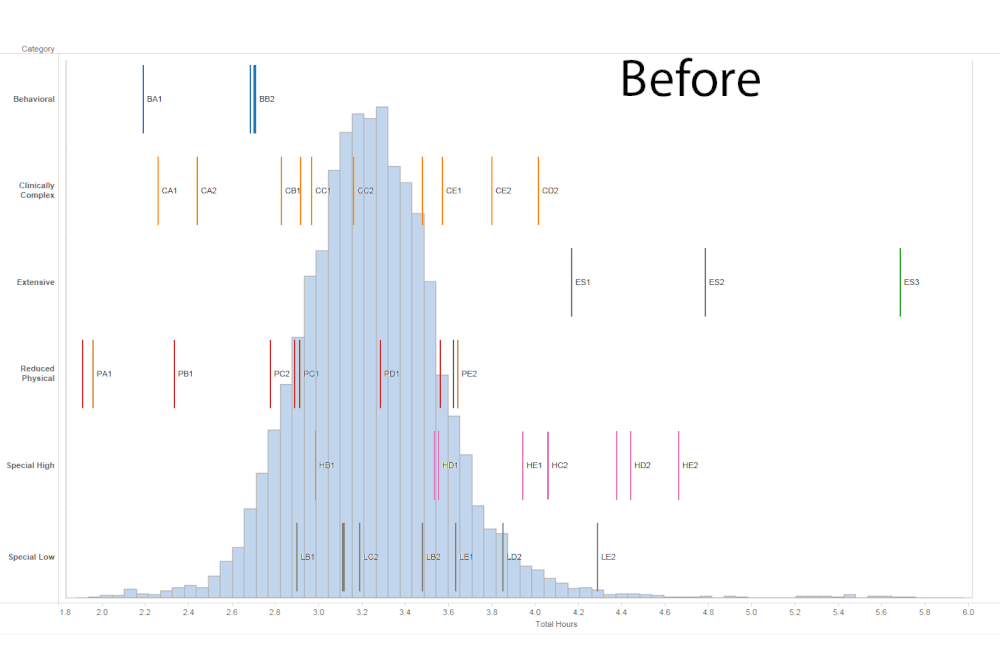There is a problem on the horizon. Under PDPM, the staffing study used to determine how many nursing hours to expect for a given RUG level will not longer work. That study, called STRIVE, was originally done between 2005 and 2009. The data from that study is used to estimate how many nursing hours (RN, LPN and aide) to expect for a given RUG level.
The staffing portion of the 5 star rating system depends on expected nursing hours, now called case-mix hours, to scale actual nursing hours by patient acuity prior to assigning stars. (See this post for more detail.)
We’ve contacted CMS to ask how this is going to be handled. As of 4/1/2019, the answer was “We haven’t decided.” CMS has a lot on its plate with the changes to the 5 star system rolling out this month and PDPM happening on October 1st.
A Proposal
One approach CMS could take is to simply mirror the idea used in the nursing portion of PDPM. They could simply combine the nursing RUGs and average the nursing times and use those.
Pros
-
It’s easy to understand and implement.
-
It doesn’t required major overhaul of the star rating system.
-
It’s cheap and fast
Cons
-
It isn’t really rigorous. It could be argued that this is a leap of faith.
I will focus on the con for a moment. While this idea isn’t statistically rigorous, I would argue that the original STRIVE study has some results that raise eyebrows anyway. I am humbly suggesting that the STRIVE study isn’t perfect. That isn’t an excuse to make decisions that aren’t supported by data, but we need to be pragmatic here. Another STRIVE study would be hugely expensive and there isn’t time prior to PDPM anyway.
Also, PDPM already combines these nursing categories. I haven’t seen any justification for this other than to reduce the overwhelming number of patient classifications. Since we’ve already made that decision, this feels like the natural way to go.
What would it look like?
I simply took the required minutes for the RUGs that have been combined and averaged them. All other RUGs are left unchanged. (Note: I am using unweighted averages here. I don’t have the data to do weighting. I would strongly suggest weighting these.)
This image shows the expected overall nursing hours by RUG for all of PDPM. I have overlaid the distribution for total nursing hours for every home in the country.

Averaging the nursing hours (click to enlarge)
How would it change my star rating?
That depends on the acuity at your facility, but the answer is probably not much. (Warning: I am now speculating.) If you watch the animation a few times, you’ll see that overall most RUGs get pulled towards the center of the existing distribution. Unless you have extremely high or low acuity, you’re probably likely to get pulled towards the center, slightly. (Remember: higher acuity will either put negative pressure on your staffing star rating or cause you to spend more in staffing for the same rating. Read the last two sections of this posting for an explanation.) More speculation: Your normal variation in acuity is probably greater than the change you’d see from this proposal.
Conclusion
Perfect is the enemy of good. Although this is clearly a compromise, it’s probably good enough. It definitely isn’t conceptually any more difficult than what we’re doing pre April 2019 change, and only requires a comparatively small leap of faith.
There are much bigger issues to work on, even in 5 star. (Transparency around which assessments are included in the 5 star rating would be an example.) Let’s just fix this and move on.
If you want Broad River Rehab to analyze your staffing and help you figure out how to get that next star, contact me. I’d love to hear from you.

